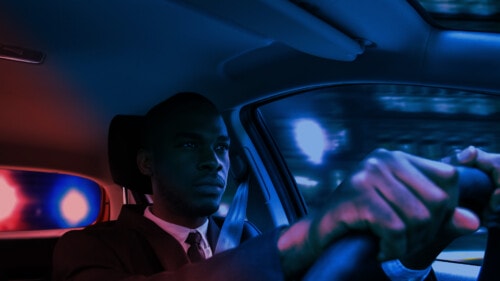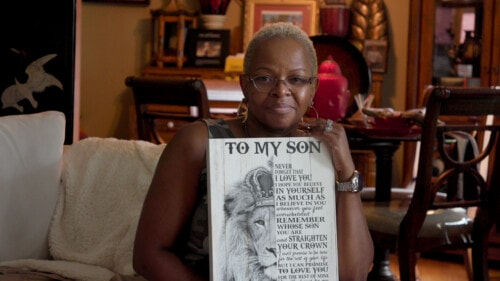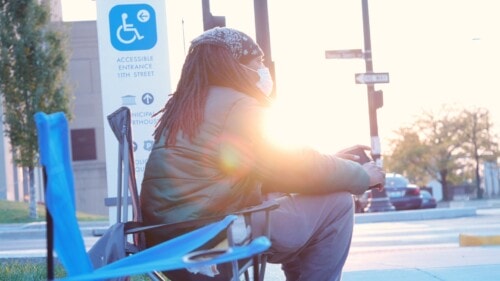- Home | News & Issues |
- Black Drivers in Missouri More Likely to be Ticketed, Arrested
Black Drivers in Missouri More Likely to be Ticketed, Arrested Same Conclusion for 23 Straight Years
Published June 5th, 2023 at 12:29 PM
Above image credit: Of the 39,302 Black drivers stopped by the patrol in 2022, nearly 35,000 were issued a citation, or 89%, with almost 7% of stops resulting in an arrest. (Douglas Sacha | Getty Images)Black drivers stopped by Missouri law enforcement are much more likely to end the encounter with a citation or in a jail cell than whites, according to the latest state report of racial data on traffic enforcement.
The report also shows that Black drivers away from their home communities – or visiting the state – tend to be stopped in higher numbers than whites away from home or both groups while in their hometowns.
Published Thursday by the Missouri Attorney General’s Office, the report compiles data on stops for 2022 from 581 of the state’s 613 police agencies. Most are municipal police or county sheriff’s departments, but the report also gathers data from specialized forces like the University of Missouri Police Department and the only statewide agency, the Missouri State Highway Patrol.
The report is the 23rd consecutive compilation of police statistics that show Black drivers are stopped at higher rates than their share of Missouri’s population.
Four of the other ethnicities listed — white, Native American, Asian and other — have been stopped every year at lower rates than their share of the population. A fifth ethnicity, Hispanic, has not had a stop rate above its share of the population since 2007.
During 2022, police made more than 1.25 million traffic stops, issued almost 550,000 citations and made 49,122 arrests. More than three-quarters of the stops were white motorists and roughly 17% were Black.
White motorists were released with a warning or no action after more than half of those stops, with just under 40% receiving a citation and arrests in 3.65% of cases. Black drivers received a citation after almost 58% of stops, with 5.26% arrested.
When the agency making the stop is the highway patrol, very few Black drivers are sent on their way with only a warning or no other action. Of the 39,302 Black drivers stopped by the patrol in 2022, nearly 35,000 were issued a citation, or 89%, with almost 7% of stops resulting in an arrest.
The patrol stopped 274,680 white drivers and issued tickets in just under 60% of cases, making arrests in 3.26% of those stops.
Reparations in KC: Panel Discussion – June 7 at 5:30 p.m.
Kansas City PBS hits the road for a conversation on reparations. Your voice matters! Be among the first to weigh in on the question of reparations in Kansas City during a community conversation co-hosted by American Public Square. Get details and register.
The report’s executive summary notes that there are a variety of reasons why there may be disparities in any individual agency’s report.
“Observed differences may result from differential impacts of policing, differential treatment by police or some combination of these and other factors,” the report states. “Differential treatment refers to bias (unintended or not), whereas differential impact refers to several potential sources of disparities that are not a direct result of bias on the part of officers conducting vehicle stops.”
Don Love of Columbia, who has been analyzing the annual vehicle stops report for more than a decade, said the difference in outcomes of stops deserves a deeper look. The report aggregates totals, so it does not indicate whether the citations were for speeding, careless driving or broken lights.
The Columbia Police Department, under pressure from local activists, releases non-identifiable data on every stop for independent analysis. More agencies will be providing that data for analysis as part of the state report, the executive summary states.
“You’ve got a much better idea of the violations the officer saw, and see whether it looks likely that any of those violations really justified the citation or, a citation instead of a warning, or a citation instead of an arrest,” Love said.
In an email, a spokesman for the patrol wrote that the agency would not be able to respond to questions about the annual report until next week.
Racial Concerns
Missouri began compiling and publishing data on vehicle stops in 2000 under a law passed in response to concerns about bias in policing. Every police agency is required to deliver data on the number of traffic stops. This year, 30 agencies did not report and could lose access to some state funding as a result.
In addition to race, gender and age of the drivers, the agencies report the locations and reasons for the stops in broad categories and the outcomes, including whether a search was conducted or contraband was found and whether the driver was cited, arrested, warned or no other action was taken.
From the data, the report also calculates what is known as a disparity index, intended to show whether drivers from any particular ethnic group are being stopped at higher rates than their share of the driver-age population.
There can be several explanations for disparities, the report states, and not all indicate racial bias. Concentrating police in high crime areas if the area has a higher concentration of an ethnic group is one example given. Another is that social or economic disadvantages may lead to different rates of offending.
The report does acknowledge that bias, whether implicit or explicit, can play a role.
“Implicit bias can be difficult to detect, even for the individual operating under its influence,” the report states.
For all reporting agencies, the disparity index for white drivers was 0.94, which means they were stopped in smaller numbers than their proportion to their population. The index for Black motorists was 1.59, which means they are being stopped at rates about 60% higher than their share of the population would indicate.
For three other small groups – Hispanic, Native American and Asian drivers – the disparity index was well under 1.
Recently added data on residency shows white drivers are pulled over in their home communities at about their share of the population, with a disparity index of 1.01. For Black drivers in their home communities, the disparity is less than the overall index, 1.21.
For the highway patrol, the disparity index for all white drivers was 1.01, and 1.05 for drivers who are Missouri residents. For Black drivers, the overall index was 1.09, the third highest recorded in the 23 years of reports, but 0.963 for Black Missouri residents.
The patrol’s overall disparity index for Hispanic drivers, about 3.7% of all Missouri drivers, was 1.09, the highest recorded, but only 0.68 for Hispanic residents of the state.
Agency Responses
Along with the required data, police agencies are given an opportunity to make comments that explain their results. Most do not, but some that have high traffic volumes wrote that while policing busy roads, they stop many people who do not live in their community.
Gladstone, near Kansas City, has a stop rate for Blacks that is five times the rate for whites and a disparity index of 3.93 for Black drivers. The city contended in its comments that the rates are meaningless because 73% of officers’ stops are non-residents.
“Since the numbers clearly show the vast majority of individuals contacted by Gladstone officers during vehicle stops are not residents, comparing the demographics of these drivers to the demographics of Gladstone’s residents will result in flawed conclusions,” the Gladstone Department of Public Safety stated.
Love said he has frequent conversations with the Clayton Police in St. Louis County about traffic stops data. The overall disparity index for Black drivers in Clayton is 4.46, but when only stops of resident Blacks are counted, it is 0.48.
As a shopping, entertainment and administrative center, Clayton has many visitors daily and the department is aggressive on traffic enforcement, Love said.
“If you look at the overall disproportion, it’s high when you figure it on the basis of residents in Clayton, but if you sort out the residents from the non-resident residents, you get a better idea of what’s going on,” he said.
One big change likely to come into play in future reports will involve motorist searches. In 2022, law enforcement conducted 75,014 searches of a driver, the vehicle or both after a stop. Of that number, drivers gave their consent in 42.5% of cases and the officer used an odor of alcohol or drugs as the probable cause for 21.6% of searches.
Among white drivers, an odor of drugs or alcohol was cited as the reason for 17.8% of searches, while for Black drivers the share was about double, 33.8%.
The constitutional amendment that legalized marijuana also prohibits law enforcement from using the odor of marijuana as grounds for a search if there is no indication that the motorist has more than the legal amount of three ounces.
Love said he would like to see more research about the disparity in searches. He said the odor is probably marijuana for Black drivers because arrest data shows that 31% of white driver arrests were for DWI, compared to 19.4% of Black driver arrests.
“I think officers were distracted by racial stereotypes,” Love said. “I can’t prove that. But it sure seems to be likely to me that blacks aren’t using drugs more frequently than whites.”
Rudi Keller covers the state budget, energy and the legislature in Missouri. This story first appeared on the Missouri Independent, a nonpartisan, nonprofit news organization covering state government, politics and policy.
More on Flatland
Decades of Data Suggest Racial Profiling is Getting Worse, Not Better Missouri law enforcement traffic stop data suggests racial profiling of Black people is worsening even as data collection continues.
Police Keep Eyes on the Street, and on Racial Disparity Data Missouri data suggests that Black drivers are targeted for law enforcement stops far more than other racial groups. But perspectives differ on what the information does and doesn’t prove,
After the Stop: People of Color With Disabilities Face More Risks With Police What do police stops look like for people of color who also intersect with the disability community?
Turning Data to Dialogue: Police Stop Data and the Search for Solutions Missouri has some of the nation’s most comprehensive and longstanding data on police traffic stops. Yet for all of the tallying and annual reports and statements of concern, little has changed.
Like what you are reading?
Discover more unheard stories about Kansas City, every Thursday.
Thank you for subscribing!
Check your inbox, you should see something from us.
Ready to read next
Omaha Postcard: Big Downtown Park Overhaul Shows How to Attract People
Read StoryRelated Stories
Kansas City-area Politicians Pick Between War on Drugs or Treatment When Spending Opioid Settlement Cash
Cities and counties in the metro are starting to spend windfalls from legal settlements with companies that made, shipped and sold opioids. While some prioritize law enforcement efforts to reduce drugs on the street, others try to attack demand by getting people into treatment.
by Suzanne King, The Beacon | 04-17-2024







